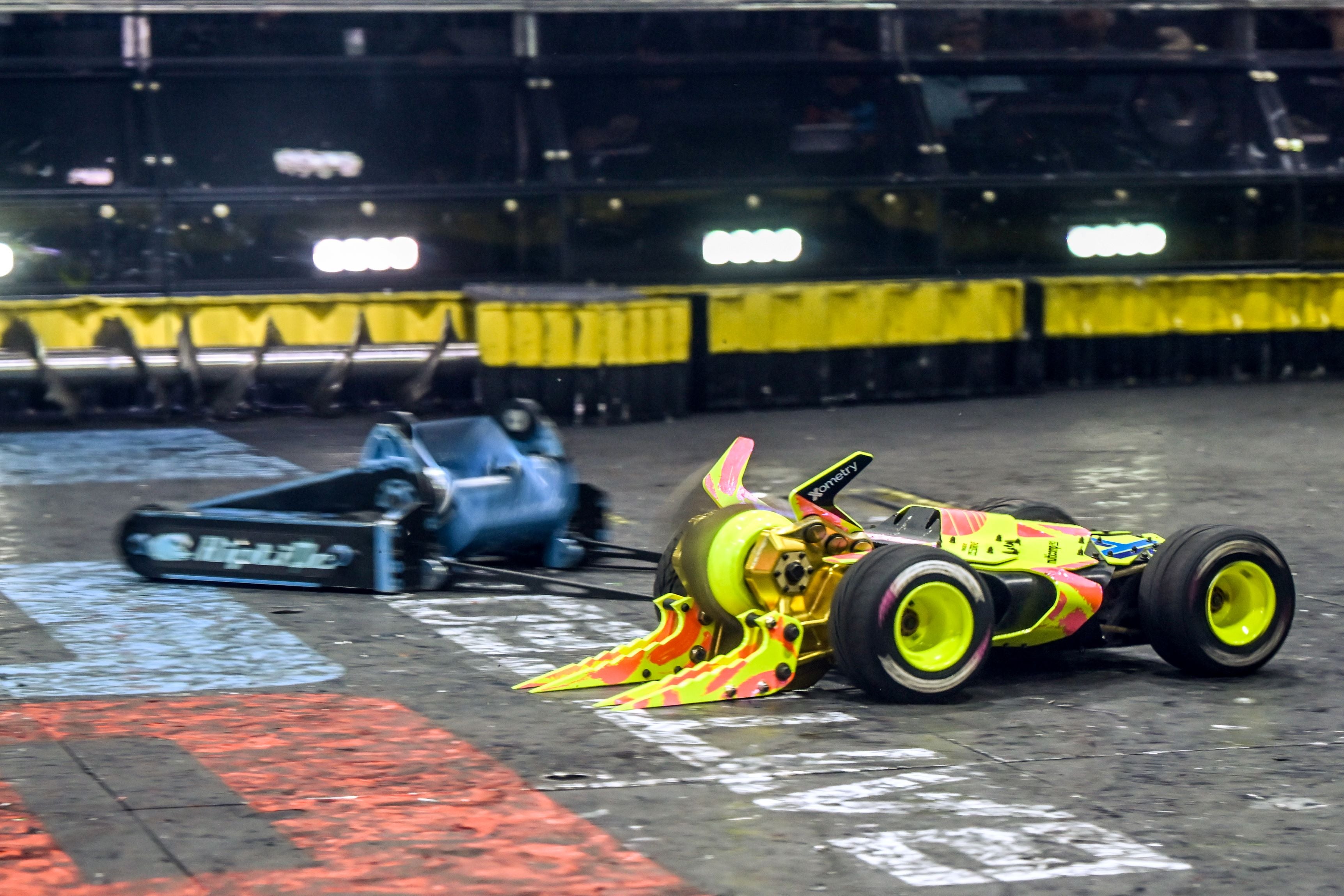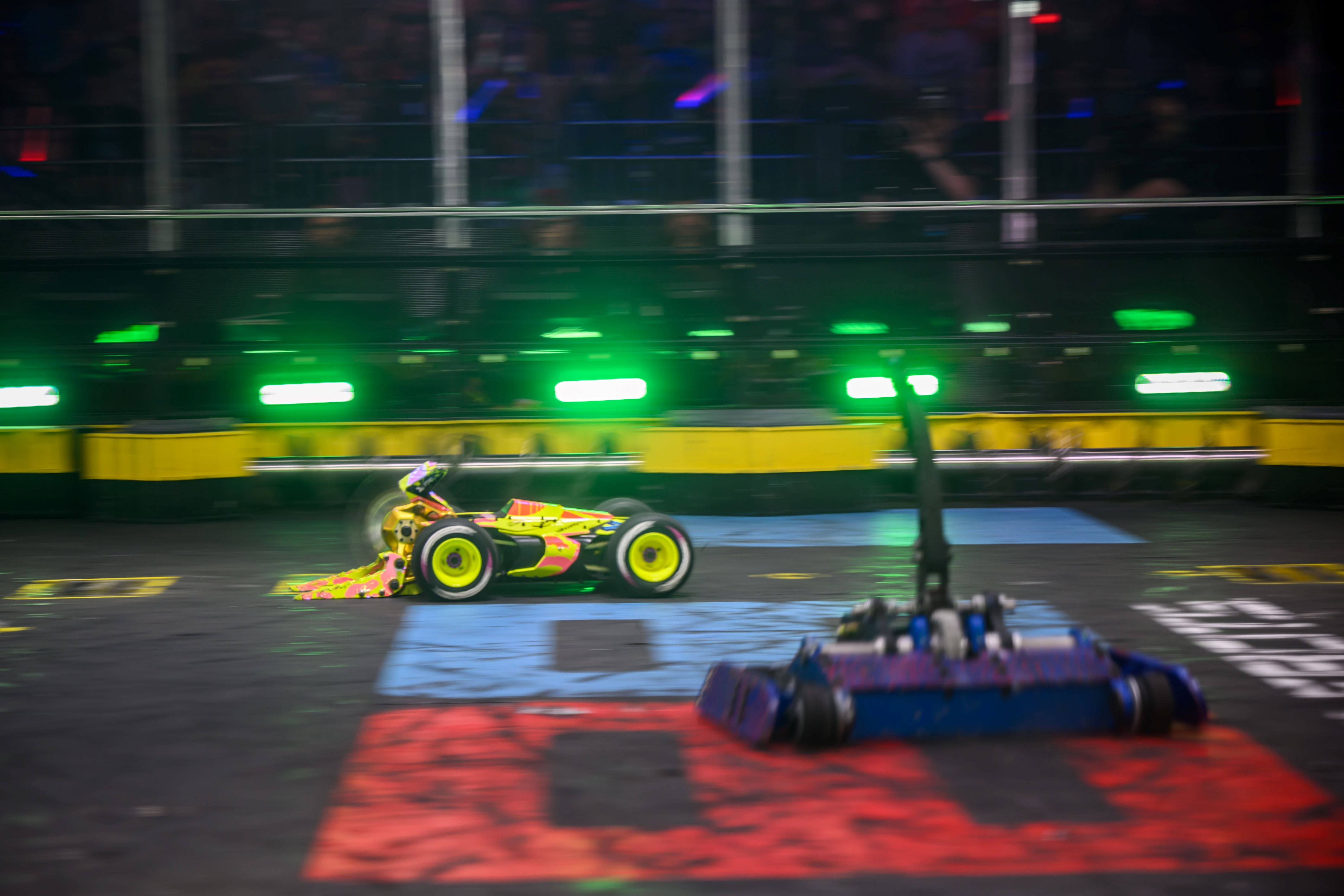Since our fight aired last week, many people have asked why we got rid of the self-righting mechanism (srimech). Some have been so bold to tell us all the reasons we need it. We’ve had a dedicated self-righter for the last two seasons. We used it once to push Valkyrie off our back and that's about the only time it worked at BattleBots. We had a working one at Robot Rukus 2019, but it took up way too much space inside the robot.

The Season 4 self righter used an 8085 and a chain reduction following a 120:1 Harmonic Drive strain wave gearbox. Here’s a video on how those work, much more enlightening than any writeup I can give you: https://youtu.be/bzRh672peNk. The total reduction was 360:1. The power was more than there, but we had 2 problems: a long wheelbase meant we needed a long lever to flip us back over, and to keep the weight down, it had to be Ti, which flexed too much. In a way, the flexibility was helpful as it reduced the initial load requirements on the mechanism. The downside was it didn’t lift the robot evenly, the soft-mounts the mechanism was on moved a lot, eventually tearing the chain free. Had we been better versed in suspension bushings, we may have had a degree more success with that version of the srimech.
We also struggled with the control system. This was the first season we experimented with hall effect sensors. The Maytech 8085 had a built-in sensor board and we initially tried to create a proper closed-loop control system. We didn’t have the time since the build was so rushed, so we settled for relying on Tyler’s dexterity with the transmitter. Unfortunately, his skilled thumbs couldn’t make up for the limitations of the mechanism. As fast as they can be, being able to drive upside down is much more important than firing the self-righter. The fastest srimech leaves a robot exposed for at least one second, plenty of time for many robots to take a free shot. To speed up a forward roll self-right, HyperShock needs to drive in the direction that would be forward while the srimech fires, then reverse directions as the srimech reaches its maximum travel.

We spent a lot of time fixing the srimech as soon as we got our crates back from BattleBots. We had had a pretty fulfilling season and were still amped up on the moderate success of making the ro24. Eventually, we determined the primary reason for the patchy performance as we had run the (very long) signal wires along the power wires going to the back of the robot. For those not familiar with why that's bad, high power wires close and parallel to low power wires is a dependable way to cause interference. Always best to keep power away from the signal, cross them at 90° if you must. Don’t wrap one around the other. The bigger the power gap, the worse the interference will be. We separated those wires and suddenly the srimech performed consistently.
This is our fight against Krusty Grab, it's the best we ever had a srimech work. You might see this fight and ask why we didn’t stick to this srimech configuration. Simply put, it was huge. We couldn’t sustain the space and weight required to keep using it once we started making changes to the rest of the robot.

On the right is the 8085 we used in 2019, on the left is a Neumotor 8012. Tiny, right? Tyler and Will figured out they could drive the strain wave gearbox through the front and have the output also come out the front. This allowed us to make the srimech power train more or less symmetric, and overall much smaller.

This is the Season 5 srimech in a partially disassembled state. Due to the concentricity requirements of the parts and all the bearings, it was egregiously expensive. We got about halfway through setting up a clever closed-loop control scheme with software endpoints. It was never finished though, so we stuck with human dexterity again. As I’ve mentioned when talking about motor sensors before, hall effect sensors do next to nothing to help with the start-up performance of a brushless motor. While all the fancy software would have been useful, it couldn’t do anything about the lack of torque to get the arm moving. We’d gone to an even more flexible arm to try to reduce the initial load on the motor and attached the module to the arm mount so it shouldn’t have been able to tear away.
This video shows one of the 3 successful self-rights we had with this srimech after it failed throughout Season 5. On the third attempt, it tore halfway off the mounts.

It's reasonable at this point in the story to blame our srimech designs, they weren’t effective. They were too complicated and couldn’t do what we needed. The srimechs drove huge parts of the chassis design. The amount of weight and space the srimechs required made them untenable to continue using. We’d gotten by in some of our matches by driving upside down. We decided to commit to just making the robot drive better while inverted. We took the roughly 40lbs we had been wasting on srimechs and put some of it into the weapon, the rest into armor. When we started discussing were to find about 10lbs for the thicker disks, the srimech stood out as underutilized weight.

Before going further, let me make one thing abundantly clear: the weapon clears the floor when the robot is upside down. The horns were bent nearly flat, that's why it wasn’t working. We’re not so dumb that we forgot to check whether they were long enough. We went with 3/16” titanium horns because we used exactly that in Season 4 and it wasn’t an issue. What changed was the angle. In Season 4, the horns were fully vertical, not bent out at a fun angle. Now, with the angle, they deformed immediately upon landing after ramping off. Funny enough, when we switched which side the horns were on (now bent up instead of out) the clearance was fine again. Regardless, we ordered thicker horns out of AR500 that evening.

With the longer wheelbase, we’re in that much better a shape to have driving power while upside down. The weapon is closer to the floor without any risk of rocking forward; it's very stable while upside down. We also have enough weapon power to gyro dance back over if we’re inverted. Hopefully, we don’t have to worry about it again, but we’ll see when the Bounty Hunters episodes air. When? No idea, wish I knew.





Share:
S6 Tournament | Matchmaker, Matchmaker, Make Me a Match
LexCon | BattleBots Goes Well at a Comic Con